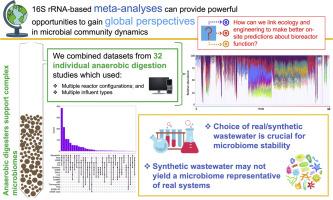当前位置:
X-MOL 学术
›
Water Res.
›
论文详情
Our official English website, www.x-mol.net, welcomes your
feedback! (Note: you will need to create a separate account there.)
Microbiomes of High-Rate Anaerobic Digestors Reveal ‘Study’-Specific Factors and Limitations of Synthetic Wastewater
Water Research ( IF 11.4 ) Pub Date : 2025-05-31 , DOI: 10.1016/j.watres.2025.123931
Ciara Keating, Anna Trego, Vincent O'Flaherty, Umer Zeeshan Ijaz
Water Research ( IF 11.4 ) Pub Date : 2025-05-31 , DOI: 10.1016/j.watres.2025.123931
Ciara Keating, Anna Trego, Vincent O'Flaherty, Umer Zeeshan Ijaz

|
Anaerobic digestion (AD) is a key technology for the treatment of organic wastes and the production of renewable energy. The stability of the process hinges on the underlying microbial populations. Amplicon sequencing is increasingly used to characterise AD microbiomes, yet sequencing efforts have not translated to process engineering of the microbiome or prediction of failure using microbial tools. Using high-rate biofilm wastewater bioreactors as a study system, we aimed to i) discern trends in archaeal and bacterial diversity, ii) identify a core AD microbiome, iii) determine the functional stability of AD microbiomes, and iv) correlate taxa to experimental conditions. We analysed amplicon sequencing data from 32 high-rate anaerobic digestor studies (> 1,258 samples) at various operational conditions and applied a suite of statistical microbiome tools. We found that taxonomic archaeal diversity was highly study dependent, while functional diversity was highly shared across studies. A core AD microbiome was identified with > 100 bacterial genera and 6 archaeal genera which were present at > 1 % relative abundance in at least 50% of samples. Interestingly, we observed that microbiome stability was significantly impacted by the choice of real or synthetic wastewater, with synthetic wastewaters yielding a more stable and less complex microbiome. This was correlated to the abundances of 37 taxa in the synthetic wastewater, including 3 key methanogens (Methanothrix, Methanobacterium, and Methanosphaerula). This suggests that when synthetic wastewater is used in experimental studies, it may not result in an AD microbiome representative of real wastewater treatment systems.
中文翻译:

高速厌氧消化池的微生物组揭示了合成废水的“研究”特定因素和局限性
厌氧消化 (AD) 是处理有机废物和生产可再生能源的关键技术。该过程的稳定性取决于潜在的微生物种群。扩增子测序越来越多地用于表征 AD 微生物组,但测序工作尚未转化为微生物组的工艺工程或使用微生物工具预测失败。使用高速生物膜废水生物反应器作为研究系统,我们的目标是 i) 辨别古细菌和细菌多样性的趋势,ii) 确定核心 AD 微生物组,iii) 确定 AD 微生物组的功能稳定性,以及 iv) 将分类群与实验条件相关联。我们分析了来自不同作条件下的 32 项高速率厌氧消化器研究(x3E 1,258 个样本)的扩增子测序数据,并应用了一套统计微生物组工具。我们发现分类学古细菌多样性高度依赖于研究,而功能多样性在研究中高度共享。用 > 100 个细菌属和 6 个古细菌属鉴定出一个核心 AD 微生物组,它们在至少 50% 的样本中以 > 1% 的相对丰度存在。有趣的是,我们观察到,选择真实废水或合成废水会显着影响微生物组稳定性,合成废水会产生更稳定且不太复杂的微生物组。这与合成废水中 37 个分类群的丰度相关,包括 3 个关键的产甲烷菌(Methanothrix、Methanobacterium 和 Methanosphaerula)。这表明,当合成废水用于实验研究时,它可能不会产生代表真实废水处理系统的 AD 微生物组。
更新日期:2025-06-01
中文翻译:

高速厌氧消化池的微生物组揭示了合成废水的“研究”特定因素和局限性
厌氧消化 (AD) 是处理有机废物和生产可再生能源的关键技术。该过程的稳定性取决于潜在的微生物种群。扩增子测序越来越多地用于表征 AD 微生物组,但测序工作尚未转化为微生物组的工艺工程或使用微生物工具预测失败。使用高速生物膜废水生物反应器作为研究系统,我们的目标是 i) 辨别古细菌和细菌多样性的趋势,ii) 确定核心 AD 微生物组,iii) 确定 AD 微生物组的功能稳定性,以及 iv) 将分类群与实验条件相关联。我们分析了来自不同作条件下的 32 项高速率厌氧消化器研究(x3E 1,258 个样本)的扩增子测序数据,并应用了一套统计微生物组工具。我们发现分类学古细菌多样性高度依赖于研究,而功能多样性在研究中高度共享。用 > 100 个细菌属和 6 个古细菌属鉴定出一个核心 AD 微生物组,它们在至少 50% 的样本中以 > 1% 的相对丰度存在。有趣的是,我们观察到,选择真实废水或合成废水会显着影响微生物组稳定性,合成废水会产生更稳定且不太复杂的微生物组。这与合成废水中 37 个分类群的丰度相关,包括 3 个关键的产甲烷菌(Methanothrix、Methanobacterium 和 Methanosphaerula)。这表明,当合成废水用于实验研究时,它可能不会产生代表真实废水处理系统的 AD 微生物组。


















































 京公网安备 11010802027423号
京公网安备 11010802027423号